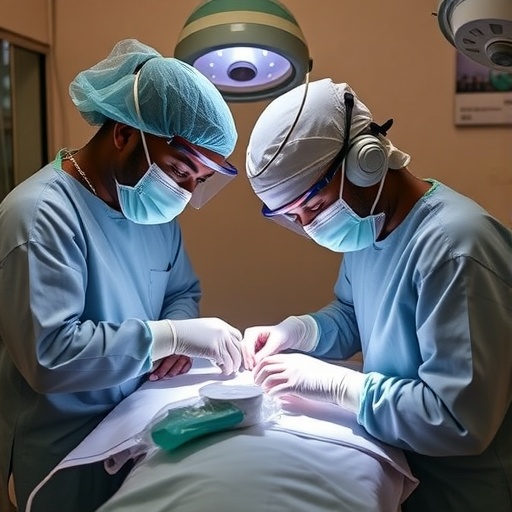High altitude environments, characterized by reduced atmospheric pressure and lower oxygen levels, have long captivated scientific inquiry, especially concerning their impact on human health. The latest findings from a retrospective cohort study led by researchers Wang, Zhang, and Guo reveal a startling correlation between high altitude exposure and a significant increase in the risk of hip fractures. This study, which utilized data from the China Health and Retirement Longitudinal Study (CHARLS), unveils crucial insights into how altitude influences bone health, particularly among aging populations.
The implications of altitude on human physiology are profound. At high elevations, the body faces a multitude of challenges, including hypoxia, which can lead to increased stress on various organ systems. Previous studies have established that prolonged residence at high altitudes can lead to cardiovascular adaptations, yet the skeletal implications have remained less understood. Wang and colleagues took a novel approach by examining hip fractures, occurrences that signify not only physical injury but also potential underlying systemic health issues aggravated by living in a high-altitude environment.
The study compiled data from over 20,000 participants in the CHARLS database, a comprehensive resource designed to represent the aging population in China. Utilizing a robust statistical framework, the researchers identified a clear association between altitude and hip fracture risk. Participants residing at elevations above 2,500 meters showed a markedly heightened risk of sustaining hip fractures compared to their low-altitude counterparts. This alarming trend is particularly concerning when considering the rapidly aging global population and increasing patterns of migration to elevated areas.
One of the study’s pivotal findings lies in the physiological mechanisms at play. High altitude can provoke an array of adaptive responses, including increased red blood cell production and alterations in metabolic processes. However, adapted bone metabolism may favor fragility, especially among older adults who already demonstrate decreased bone density. The authors emphasized the need for further research to explore the biochemical pathways potentially influencing bone strength in this demographic. Their results suggest that the bone remodeling process may become adversely affected under hypoxic conditions, highlighting a significant consideration for public health and policy initiatives aimed at elder care in mountainous regions.
Apart from direct physical impacts, the study also brings to light the social determinants of health as they pertain to high-altitude living. Higher elevations often correlate with rural settings where access to healthcare is limited. This compounding of factors may exacerbate outcomes for elderly populations, who are often less mobile and more susceptible to falls that lead to fractures. Recognizing this intersection of altitude, aging, and social health determinants calls for tailored interventions that target not just medical aspects, but also build infrastructure that enhances the well-being of residents in elevated regions.
Moreover, these findings resonate with broader public health concerns regarding aging populations globally. The World Health Organization estimates that by 2050, the number of people aged 60 and older will reach 2 billion. With such demographic shifts come greater public health challenges, necessitating an understanding of the unique stressors faced by older adults, especially those in high-altitude environments. This piece of research serves as a stepping stone towards comprehensive health strategies that consider geographical and environmental variables.
As scientists digest these findings, questions about preventive measures arise. What strategies can be employed to mitigate the risks associated with high-altitude living? Education on fall prevention, the promotion of bone health through lifestyle and nutritional interventions, and the implementation of community support systems are vital components that could offset the risk of hip fractures among elderly populations residing in high-altitude areas.
In addition, the results beckon further investigation into potential genetic or epigenetic factors that may predispose certain individuals to hip fractures at high altitudes. Understanding these predispositions could lead to the development of personalized medicine approaches that offer tailored prevention strategies based on individual risk profiles.
In summary, the work of Wang, Zhang, Guo, and their colleagues not only adds a valuable chapter to the literature on high-altitude health effects but also ignites a spark for future research. It challenges the scientific community to delve deeper into the multi-faceted relationships between environment, aging, and health. As the global landscape shifts and more individuals inhabit higher elevations, the urgency for such research becomes ever more palpable.
This landmark study shines a light on a crucial yet often overlooked aspect of geriatric health, leaving us with a powerful message: as we climb to new heights, we must ensure that the health of our aging population is not left behind.
Subject of Research: Exposure to high altitude and risk of hip fracture in older adults.
Article Title: Exposure to high altitude is associated with an elevated risk of hip fracture: a retrospective cohort study using data from the CHARLS.
Article References: Wang, S., Zhang, F., Guo, Y. et al. Exposure to high altitude is associated with an elevated risk of hip fracture: a retrospective cohort study using data from the CHARLS. BMC Geriatr 25, 884 (2025). https://doi.org/10.1186/s12877-025-06492-6
Image Credits: AI Generated
DOI: https://doi.org/10.1186/s12877-025-06492-6
Keywords: high altitude, hip fracture, aging populations, bone health, CHARLS, public health.
Tags: aging populations and bone healthaltitude exposure effects on human physiologycardiovascular adaptations at altitudeChina Health and Retirement Longitudinal Studyenvironmental factors and bone injurieshigh altitude health riskshypoxia and skeletal implicationsincreased hip fracture riskphysiological challenges of high altituderesearch on fractures in elderly populationsretrospective cohort study on altitudesystemic health issues in aging





